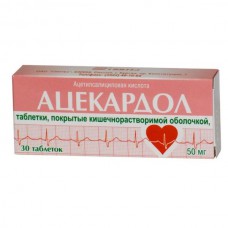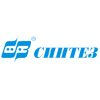Expiration date: 06/2027
Release form and composition:
Tablets, covered with kishechnorastvorima liner white or almost white, round, lenticular.
1 tablet contains:
acetylsalicylic acid 50, 100 or 300 mg
Excipients: povidone, corn starch, lactose, microcrystalline cellulose, magnesium stearate, talc, acetylcellulose, titanium dioxide, castor oil.
10 PCs. - packaging sells contoured (3) - packs cardboard.
Pharmacological action:
Nonsteroidal anti-inflammatory drug (NSAID). The basis of the mechanism of action of acetylsalicylic acid lies in the irreversible inhibition of COX, the result is blockade of the synthesis of thromboxane A2 and inhibits the aggregation of platelets. It is believed that acetylsalicylic acid has other mechanisms of suppression of platelet aggregation, that broadens the scope of its application in various vascular diseases. Acetylsalicylic acid has also anti-inflammatory, analgesic, antipyretic action.
Pharmacokinetics:
Suction
After ingestion, acetylsalicylic acid is absorbed from the upper part of the small intestine. Cmax in plasma was on average 3 h after administration of the drug inside.
Metabolism
Acetylsalicylic acid undergoes partial hepatic metabolism with formation of less active metabolites.
Excretion
Excreted by the kidneys as unchanged and metabolites T1/2 acetylsalicylic acid is about 15 min, metabolites - about 3 h.
Indications:
- prevention of acute myocardial infarction in the presence of risk factors (e.g., diabetes, hyperlipidemia, hypertension, obesity, Smoking, old age)
- prevention of recurrent myocardial infarction
- unstable angina
- prevention of stroke (including patients with transient disorders of cerebral circulation)
- prevention of transient disorders of cerebral circulation
- prevention of thromboembolism after surgery and invasive procedures on vessels (e.g., aorta-coronary bypass grafting, endarterectomy of the carotid arteries, arteriovenous bypass grafting, angioplasty of carotid arteries)
- prevention of deep vein thrombosis and thromboembolism pulmonary artery and its branches (for example, when prolonged immobilization in a result of big surgical intervention).
Dosing regimen:
The tablets should be taken orally before eating, squeezed more liquid. The drug is intended for prolonged use. The duration of therapy determined by the treating physician.
Prevention in cases of suspected acute myocardial infarction: 100-200 mg/day or 300 mg a day (the first tablet should be chewed for faster absorption).
Prevention of new-onset acute myocardial infarction in the presence of risk factors: 100 mg/day or 300 mg a day.
Prevention of re-myocardial infarction, unstable angina, prevention of stroke and transient disorders of cerebral circulation, prevention of thromboembolic complications after surgical operations or invasive studies: 100-300 mg/day.
Prevention of deep vein thrombosis and thromboembolism pulmonary artery and its branches: 100-200 mg/day or 300 mg a day.
Side effects:
Allergic reactions: urticaria, Quincke's edema, anaphylactic reactions.
From the digestive system: nausea, heartburn, vomiting, pain in the stomach, ulcerative lesions of the mucous membrane of the stomach and duodenum (including perforated), gastrointestinal bleeding, increased liver enzymes.
The respiratory system: bronchospasm.
With the hematopoietic system: increased bleeding is rarely anemic.
CNS: dizziness, noise in the ears.
Contraindications:
- erosivno-azwenne defeat of the gastrointestinal tract
- gastrointestinal bleeding
- hemorrhagic diathesis
- bronchial asthma, induced by ingestion of salicylates and NSAIDs, triad Fernand-Vidal, (combination of bronchial asthma, recurrent polyposis of the nose and paranasal sinuses and intolerance of ASA)
- combined use with methotrexate dose 15 mg/week. and more
- I and III trimesters of pregnancy
- lactation (breast feeding)
- the age 18 years
- hypersensitivity to acetylsalicylic acid and/or other components of the drug
- hypersensitivity to other NSAIDs.
With caution should use the drug for gout, hyperuricemia, when specifying a history of ulcerative lesions of the gastrointestinal tract or gastrointestinal bleeding, kidney and liver failure, bronchial asthma, chronic respiratory diseases, hay fever, nasal polyposis, allergic reactions to other drugs, in the II trimester of pregnancy, in combination with methotrexate at a dose less than 15 mg/week, when vitamin K deficiency, deficiency of glucose-6-phosphate dehydrogenase.
Pregnancy and lactation:
The use of salicylates in high doses in the first trimester of pregnancy is associated with an increased rate of defects of fetus development (cleft palate, heart defects). In the second trimester of pregnancy salicylates can be assigned only subject to the rigorous assessment of the expected benefit of therapy for the mother and the potential risk to the fetus.
In the third trimester of pregnancy salicylates in high doses (over 300 mg/day) cause inhibition of labour, premature closure of the ductus arteriosus in the fetus, increased bleeding in the mother and fetus, and the appointment immediately before childbirth can cause intracranial hemorrhages, especially in preterm infants. The appointment of salicylates (including acetylsalicylic acid) in the III trimester of pregnancy is contraindicated.
Salicylates and their metabolites in small amounts excreted in breast milk. Casual reception salicylates during lactation is not accompanied by the development of adverse reactions in children and do not require discontinuation of breastfeeding. However, prolonged use of the drug or appoint him to a high dose breast-feeding should be discontinued immediately.
Special instructions:
The patient can take the drug after doctor's prescription.
Acetylsalicylic acid can induce bronchospasm, as well as cause asthma attacks and other hypersensitivity reactions. Risk factors are the availability of bronchial asthma in history, hay fever, nasal polyposis, chronic respiratory diseases, and allergic reactions to other drugs (e.g., skin reactions, itching, hives).
Aspirin can cause bleeding of varying severity during and after surgery.
The combination of acetylsalicylic acid with anticoagulants, with thrombolytic drugs, and antiplatelet drugs is accompanied by an increased risk of bleeding.
Acetylsalicylic acid in low doses can trigger the development of gout in predisposed individuals (with reduced excretion of uric acid).
Combined therapy of acetylsalicylic acid with methotrexate is accompanied by increased incidence of side effects from the blood.
Acetylsalicylic acid in high doses has hypoglycemic effect, that should be kept in mind when assigning its patients with diabetes, receiving gipoglikemicakie preparations.
In combined administration of corticosteroids and salicylates should be remembered that during treatment, the levels of salicylates in the blood is reduced, and after the abolition of the SCS is possible overdose of salicylates.
Not recommended combination of acetylsalicylic acid with ibuprofen, because the latter affects the beneficial effect Acetaldol® on lifetime.
Excess doses of acetylsalicylic acid carries a risk of gastrointestinal bleeding.
Overdose is especially dangerous in elderly patients.
The combination of acetylsalicylic acid with alcohol increased the risk of damage to the mucosa of the gastrointestinal tract and lengthening the bleeding time.
Effects on ability to drive vehicles and management mechanisms
Not observed the influence of the drug on the ability to drive vehicles and management mechanisms.
Overdose:
Overdose symptoms of moderate severity: nausea, vomiting, tinnitus, hearing loss, dizziness, confusion.
Treatment: dose reduction of the drug.
Symptoms of severe overdose: fever, hyperventilation, ketoacidosis, respiratory alkalosis, coma, circulatory and respiratory failure, severe hypoglycemia.
Treatment: immediate hospitalization in specialized departments for carrying out emergency therapy - gastric lavage, definition of acid-base balance, alkaline and forced alkaline diuresis, hemodialysis, the introduction of solutions, activated carbon, symptomatic therapy. When carrying out alkaline diuresis it is necessary to achieve pH values between 7.5 and 8. Forced alkaline diuresis should be performed when concentration of salicylates in plasma is more than 500 mg/l (3.6 mmol/l) in adults and 300 mg/l (2.2 mmol/l) in children.
Drug interactions:
With simultaneous use of acetylsalicylic acid increases the effect of the following drugs:
- of methotrexate by reducing renal clearance and ousting him from the blood
- heparin and indirect anticoagulants due to an impairment of platelet function and displacement of anticoagulants from the blood
- thrombolytic and antiplatelet drugs (ticlopidine)
- digoxin due to the decrease in its renal excretion
- gipoglikemicakih funds (insulin and sulfonylureas derivatives) due to the hypoglycemic properties of acetylsalicylic acid in high doses and displacement derived sulfonylureas from the protein due to
- valproic acid due to displacement from its Association with proteins.
Acetylsalicylic acid reduces the effect of uricosuric drugs (benzbromarone) due to the competitive tubular elimination of uric acid.
Enhancing the elimination of salicylates, systemic corticosteroids are weakening their action.
An additive effect is observed while admission of acetylsalicylic acid with alcohol.
Terms and conditions of storage:
The drug should be stored out of reach of children, dry, protected from light place at temperature not exceeding 25°C. shelf Life - 3 years.




